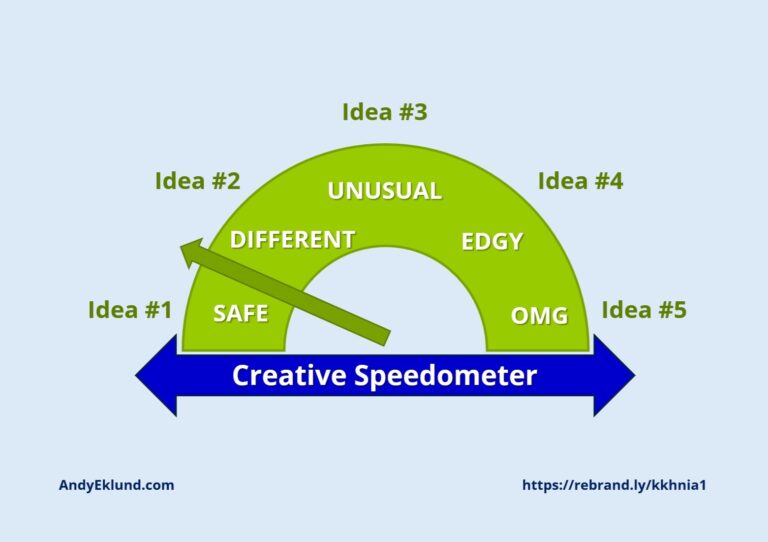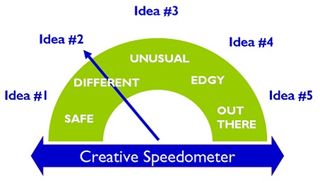In an earlier post on , I missed the one I think is most challenging: “That’s not creative.“
It’s extremely difficult to refute a response based entirely on someone’s subjective opinion.
The problem is creativity has no standardised measurement, unlike things such as flour, blood pressure, earthquakes or waist lines.
Yet, everyone agrees that all ideas have some level of creativity. Say, on a scale from 0 to 10, although it gets trickier when trying to quantify that opinion.
The Creative Speedometer
I’ve found one potential way around this problem. The solution is to present several ideas together, putting them in context with the others, in a tool I call the Creative Speedometer. (“Creativometer?”)
At the end of the brainstorm, the team and I hone the ideas into those most “sellable.” Then we plot the ideas along a continuum (Idea #1, Idea #2, etc.) such as the green arc of the Creativometer.
We put the safest and simplest ideas on the left and work our way around to the risky and heart-stopping ideas on the right.
The key: No idea on the Creativometer is not creative.
Yes, it’s a bit of an arbitrary exercise, but it doesn’t have to be. You can gauge your ideas in a number of ways:
- by budget
- by complexity
- by sheer daring or boldness
- by potential media reach, publicity or website clicks
- by potential number of attendees, participants, employees, end users
If you really want to be manipulative – oops, I meant strategic – I’d suggest you use your . But as I’ve noted elsewhere, you’d better have a firm understanding of how they’re going to judge your ideas.
How To Use the Speedometer In a Presentation
Here’s some ways I’ve used the Speedometer in the past to avoid the conversation that our team’s ideas were not creative.
Always start with the business strategy. You can’t sell an idea that won’t make the business more successful. I’d also make sure the majority of the “strategy” section is the decision maker’s words. You want them to see themselves on the PowerPoint slide or whatever tool you’re using to present your work. It’s an easy to show you listened and heard what they said.
Unveil the Speedometer at the TADA! moment. All creative presentations eventually get to the TADA! moment – that slide, storyboard, visual image, presentation stunt – where your idea is announced with great acclaim and fanfare to the universe.
By the way, if your presentation doesn’t have that TADA moment, you just screwed yourself. That’s the moment the decision maker has been waiting for! Don’t create or allow an anti-climax moment in your own presentation.
Explain how the Creativometer works. It usually comes down to something like this: “All ideas are slotted on a scale from mild to wild. We believe/know every one of them will help us/you achieve the desired outcome. How “risky” you want to be is up to you.
Here's Why 'No Creative' Is Off the Table
“Which idea would you like to see first?”
First, it puts the presentation under the control of the decision maker, not yourself. As it should be.
Second, it positions all ideas in context of creativity. There’s no “that idea is not creative.”
Third, it gives the decision maker options. Options means the decision maker will more likely be comfortable, which is more than half the battle in getting an idea sold.
Fourth, it’s a great psychological tool, because you learn a lot about the decision maker by which idea they select first, and the order in which they pick the ideas.
A decision maker that starts at the safest first and works their way up is a completely different client than one who picks the riskiest first and works their way down.
Best of all, the Creativometer is infinitely adaptable.
- For a pitch to a global restaurant chain, we changed it to an oven dial.
- For a nursing society, it became a blood pressure monitor.
- For a global automobile manufacturer, we literally super-imposed the Creativometer on to the actual speedometer of their best selling car.
How else have you addressed the decision maker’s negativity in selling ideas? Please add your thoughts and comments below.



No comment yet, add your voice below!